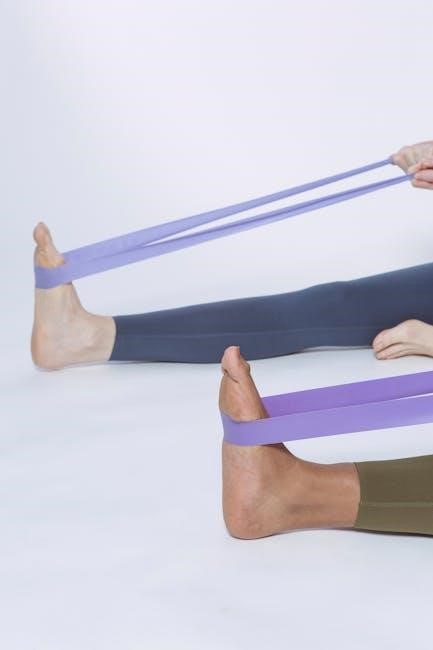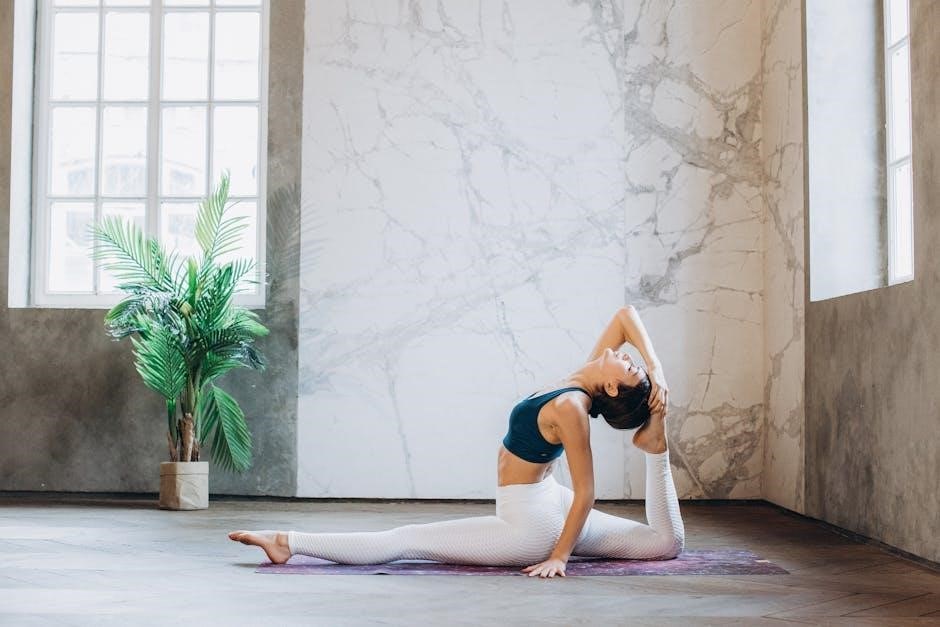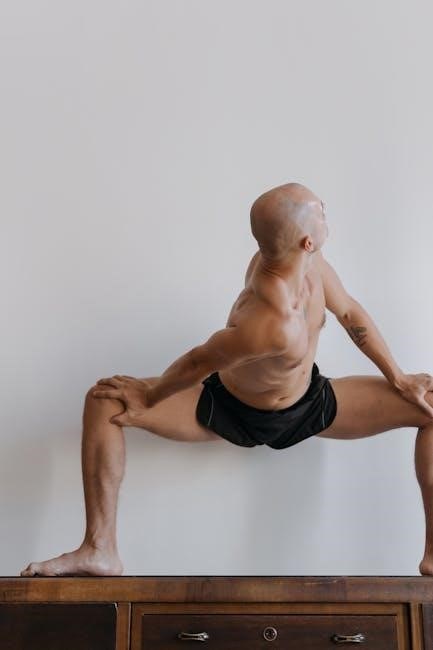The psoas muscle‚ a deep core stabilizer‚ often becomes tight. Stretching it is crucial for hip mobility and overall well-being. Incorporating specific psoas stretches can alleviate tension. Regular stretching promotes better posture and reduces lower back discomfort.
Importance of Psoas Health
Maintaining psoas health is vital for overall physical well-being. The psoas muscle plays a significant role in movement‚ posture‚ and balance. A healthy psoas contributes to improved athletic performance and reduced risk of injury. Tightness in the psoas can lead to lower back pain‚ hip discomfort‚ and even digestive issues.
Regular stretching and exercises targeting the psoas can alleviate these problems. A flexible and strong psoas facilitates efficient movement patterns and supports spinal health. It also impacts emotional well-being‚ as tension in the muscle can contribute to stress and anxiety. Prioritizing psoas health is essential for a balanced and active lifestyle. Addressing imbalances can lead to a greater sense of physical and mental ease.
Brief Overview of Psoas Function
The psoas major is a deep-seated core muscle connecting the lumbar spine to the femur. Its primary functions include hip flexion‚ external rotation‚ and lumbar spine stabilization. It plays a vital role in walking‚ running‚ and maintaining upright posture. The psoas also influences balance and agility during movement. It works in conjunction with other muscles to support the core and facilitate efficient motion.
A healthy psoas allows for a full range of hip movement. It contributes to proper spinal alignment and reduces strain on surrounding joints. Dysfunction in the psoas can lead to movement restrictions‚ pain‚ and postural imbalances. Understanding its function is essential for targeted stretching and strengthening exercises.

Understanding the Iliopsoas
The iliopsoas is a powerful muscle group composed of the psoas major and iliacus. Understanding its anatomy and function is crucial for effective stretching. These muscles significantly influence hip and spinal health.
Anatomy of the Iliopsoas Muscle
The iliopsoas is actually two muscles‚ the psoas major and the iliacus‚ working together. The psoas major originates from the lumbar vertebrae (T12-L5)‚ descending through the abdomen. It joins the iliacus‚ which arises from the iliac fossa‚ the large‚ curved bone of the pelvis.
Together‚ they form a single tendon that inserts onto the lesser trochanter of the femur‚ located on the inner thigh. This unique arrangement makes the iliopsoas the primary hip flexor‚ playing a crucial role in bringing the thigh towards the torso. Its deep location also connects the upper and lower body.
Understanding the origin and insertion points is essential for properly targeting stretches and exercises. Tightness in this area can lead to various postural and movement issues.
Role of the Iliopsoas in Movement
The iliopsoas muscle is fundamental to many daily movements. Its primary function is hip flexion‚ enabling actions like walking‚ running‚ climbing stairs‚ and even sitting up from a lying position. Every time you lift your knee towards your chest‚ the iliopsoas is actively engaged.
Beyond hip flexion‚ the iliopsoas also contributes to lateral rotation and abduction of the hip‚ albeit to a lesser extent. It plays a critical role in maintaining balance and stability of the spine and pelvis. A healthy‚ flexible iliopsoas ensures efficient and pain-free movement patterns.
Conversely‚ a tight or weak iliopsoas can significantly impair movement. It can lead to compensatory patterns‚ affecting other muscle groups and potentially causing pain in the lower back‚ hips‚ and knees. Addressing iliopsoas health is vital for optimal biomechanics.

Effective Psoas Stretches
Several stretches target the psoas effectively. Lunges‚ table stretches‚ and kneeling hip flexor stretches are beneficial. Consistent practice can improve flexibility. Remember to perform stretches slowly and mindfully for optimal results.
Classic Lunge Stretch
The classic lunge stretch is a fundamental exercise for targeting the psoas muscle. Begin by stepping forward with one leg‚ bending your knee to 90 degrees‚ ensuring it stays aligned over your ankle. The other leg should be extended behind you‚ knee resting gently on the floor or a padded surface. Maintain an upright posture‚ engaging your core to stabilize your spine. Gently push your hips forward‚ feeling a stretch in the front of your hip and upper thigh of the back leg. It is important to keep your back straight and avoid leaning too far forward. Hold this position for 30 seconds‚ breathing deeply and evenly. Repeat on the opposite side to ensure balanced flexibility. This stretch effectively lengthens the psoas‚ improving hip mobility and reducing lower back tension. Remember to listen to your body and avoid pushing beyond a comfortable range of motion.
Table Iliopsoas Stretch
The Table Iliopsoas Stretch offers a unique approach to targeting the psoas. Begin by lying on your back near the edge of a table or bed. Position yourself so that one leg can hang freely off the side. Bend your opposite knee and draw it towards your chest‚ holding it in place with your hands. This stabilizes your lower back and pelvis. Allow the leg hanging off the table to relax completely. Gravity will assist in gently stretching the iliopsoas muscle. Focus on breathing deeply and relaxing into the stretch. You should feel a lengthening sensation in the front of your hip. Hold this position for approximately 30 seconds‚ then slowly return to the starting position. Repeat on the other side to ensure both sides of the iliopsoas are stretched equally. This stretch is particularly effective for those with limited mobility or back pain‚ as it minimizes pressure on the spine while maximizing the stretch on the targeted muscle.
Kneeling Hip Flexor Stretch with Reach
The Kneeling Hip Flexor Stretch with Reach effectively targets the psoas and surrounding hip flexors. Begin by kneeling on a soft surface‚ like a mat. Position one leg forward‚ bent at a 90-degree angle‚ ensuring your knee stays directly above your ankle. The other knee should remain on the ground. Gently tuck your tailbone under‚ engaging your core muscles to stabilize your pelvis. Lean forward slightly‚ feeling a stretch in the front of your hip and thigh of the kneeling leg. To deepen the stretch‚ raise the arm on the same side as your kneeling leg overhead‚ reaching slightly towards the opposite side. This added reach further extends the psoas muscle. Hold the stretch for 30 seconds‚ breathing deeply. Ensure you maintain proper form throughout the stretch. Avoid arching your back excessively. Repeat on the opposite side‚ maintaining consistency for balanced flexibility. This stretch is excellent for improving hip mobility and alleviating lower back pain associated with tight hip flexors.

Advanced Psoas Stretching Techniques
Enhance psoas flexibility with advanced techniques. Explore using a stretch-out strap for deeper engagement. Supine psoas release can target specific tension points. These methods require careful execution and body awareness.
Using a Stretch-Out Strap
A stretch-out strap offers a versatile approach to deepening psoas stretches. Begin by looping the strap around your foot while lying supine. Holding the strap with your hands on the same side‚ gently pull your leg towards your chest‚ feeling a stretch in your hip flexor and psoas. Adjust the strap’s position to target different areas of tension. Maintaining a slow‚ controlled movement is essential to avoid injury.

The strap allows for increased range of motion and control‚ helping you gradually improve flexibility. Explore variations by slightly rotating your leg inward or outward to target different fibers of the psoas. Remember to breathe deeply and relax into the stretch. Consistency is key; perform this stretch regularly for optimal results.
Supine Psoas Release
The supine psoas release is a gentle technique to alleviate psoas tension while lying on your back. Start by lying flat with your knees bent and feet on the floor. Gently tilt your pelvis to flatten your lower back against the floor‚ engaging your abdominal muscles. Slowly extend one leg along the floor‚ keeping the other knee bent.
Focus on relaxing the hip flexor of the extended leg‚ allowing gravity to assist in releasing the psoas. Breathe deeply and hold the position‚ noticing any sensations in your hip and lower back. If you experience discomfort‚ slightly bend the extended leg. Repeat on the opposite side. This method encourages relaxation and passive release of the psoas muscle.

Considerations and Precautions
Prioritize safety when stretching the psoas. Listen to your body and avoid pushing past your limits; Individuals with certain conditions should consult a healthcare professional before beginning. Proper form is essential to prevent injuries.
When to Avoid Psoas Stretches

Certain conditions warrant caution or avoidance of psoas stretches. If you have acute lower back pain‚ especially if it’s sharp and sudden‚ refrain from stretching until evaluated by a medical professional. Individuals with suspected or confirmed psoas muscle strains or tears should avoid stretching to prevent further injury. People experiencing hip impingement or labral tears should modify or avoid stretches that exacerbate pain. Inflammatory conditions like psoas bursitis or tendinitis require rest and treatment; stretching can worsen inflammation. If you’ve recently undergone hip or abdominal surgery‚ consult your surgeon before starting any psoas stretching routine. Always listen to your body and stop if you experience pain.
Importance of Proper Form
Maintaining correct form during psoas stretches is crucial to prevent injury and maximize effectiveness. Proper alignment ensures the stretch targets the psoas muscle effectively‚ avoiding strain on surrounding tissues. An incorrect posture can lead to lower back pain‚ hip discomfort‚ or even muscle strains. Engage your core muscles to stabilize your spine and pelvis during each stretch. Avoid arching your back excessively‚ as this can compress the lumbar vertebrae. Focus on controlled movements‚ avoiding jerky or bouncing motions. If a stretch causes sharp pain‚ stop immediately and reassess your form. Consider seeking guidance from a physical therapist or qualified instructor to learn proper technique and modifications if needed. They can provide personalized feedback.

Integrating Psoas Stretches into a Routine
Psoas stretches can be easily integrated into your daily routine. Consistent stretching yields the best results. Combine them with other exercises for a balanced workout. Listen to your body and adjust as needed.
Frequency and Duration
To effectively improve psoas muscle flexibility‚ consistency is key. Aim to incorporate psoas stretches into your routine multiple times per week. A good starting point is to stretch the psoas muscle 2-3 times daily‚ dedicating time in the morning and evening. Each stretching session should involve holding each stretch for approximately 30 seconds. This duration allows the muscle fibers to lengthen and release tension.
Remember to breathe deeply and maintain proper form throughout each stretch. Over time‚ you can gradually increase the hold time to 45-60 seconds as your flexibility improves. Listen to your body‚ and avoid pushing yourself too hard‚ especially when first starting. Regular‚ shorter sessions are more beneficial than infrequent‚ intense ones. Maintaining a consistent stretching schedule will help improve your posture and promote overall well-being.
Combining with Other Exercises

Psoas stretches are most effective when integrated with a holistic exercise routine. Include them alongside exercises that strengthen the core and hip muscles. Consider incorporating activities like Pilates or yoga‚ which naturally target the psoas. Strengthening exercises for the abdominal muscles and glutes help to stabilize the pelvis. This provides greater support and allows the psoas to function more efficiently.
For example‚ after stretching the psoas‚ you can perform planks‚ glute bridges‚ or bird-dog exercises. Cardiovascular activities like walking or swimming can also improve blood flow to the psoas muscle‚ enhancing flexibility. Combining these exercises will contribute to a well-rounded fitness regimen that supports overall psoas health. Remember to listen to your body and adjust your routine as needed.



